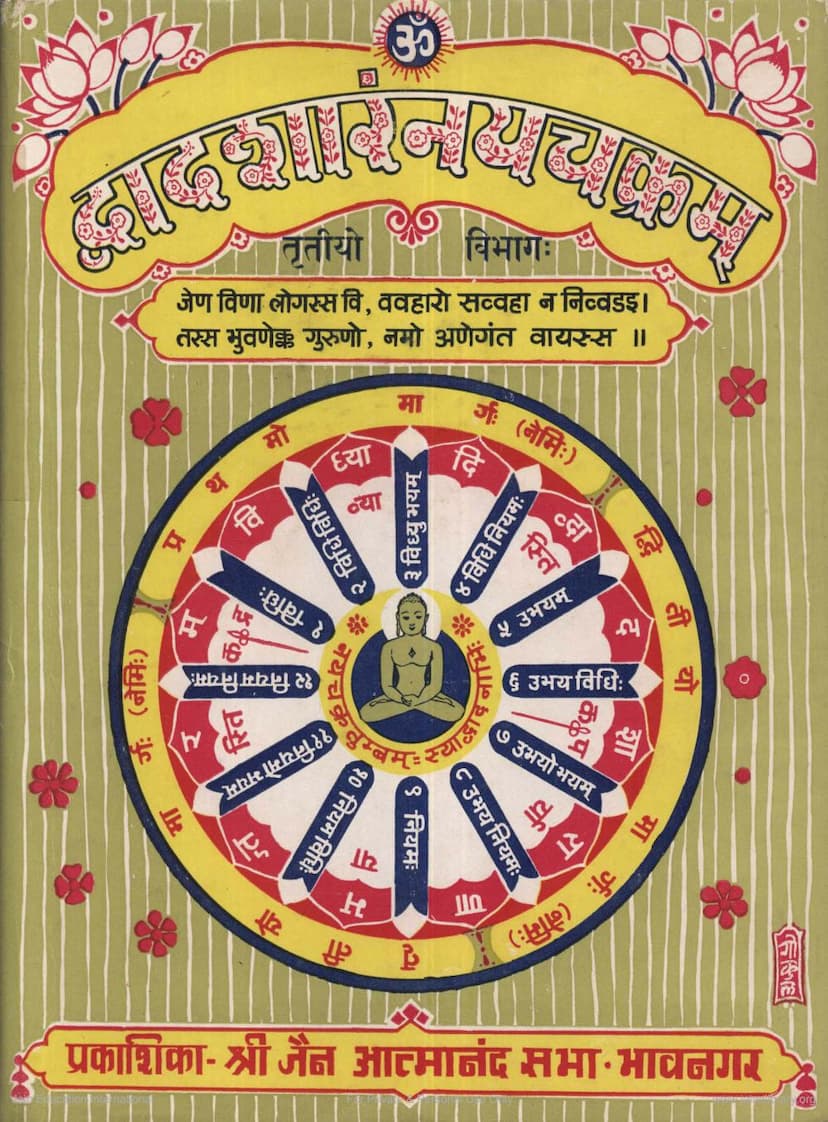Dvadasharam Naychakram Part 3 Tika
Added to library: September 1, 2025

Summary
Here's a comprehensive summary of the Jain text "Dvadasharam Naychakram Part 3 Tika" based on the provided text excerpts:
Overall Title: Dvādasāram Nayacakram (The Twelve Nayas of the Wheel of Logic) Author: Ācārya Śrī Mallavādi Kṣamāśramaṇa Commentary: Nyāyāgamānuṣāriṇī Vṛttī (Commentary According to the Principles of Logic) Commentator: Ācārya Śrī Simhasūri Gaṇi Vādīkṣamāśramaṇa Part: III (Chapters 9-12) Editor: Muni Jambūvijaya Assisted by: Muni Dharmachandravijaya Publisher: Śrī Jaina Ātmānanda Sabhā, Bhavnagar Year: Vikrama Samvat 2044 / Vīra Samvat 2514 / A.D. 1988
Summary of Contents and Key Features:
This volume (Part III) of Dvādasāram Nayacakram, along with its commentary, is a significant scholarly work presenting the final four chapters (Aras 9-12) of Mallavādi Kṣamāśramaṇa's foundational Jain text on logic and epistemology. The editor, Muni Jambūvijaya, has painstakingly reconstructed and edited this complex philosophical work with immense dedication and scholarly rigor.
Significance and Scholarly Value:
- Reconstruction of a Lost Text: The text of the Nayacakram itself is not extant independently. This edition is a reconstruction based on Simhasūri's extensive commentary, which quotes passages from the original. This reconstruction is crucial for understanding the older period of Indian philosophy, many of whose works are lost.
- Critical Edition: Muni Jambūvijaya's meticulous work, involving the consultation of numerous manuscripts and critical notes, makes this edition of the highest importance. His effort in tracing quotations, even those only partially cited by the commentator, is highly commendable.
- Insights into Indian Philosophy: The work provides deep insights into Jain philosophy, particularly its complex logical framework (Nayavāda and Anekāntavāda), and its engagement with other Indian philosophical schools, notably Buddhism.
- Commentary's Importance: Simhasūri's commentary, Nyāyāgamānuṣāriṇī, is invaluable for understanding Mallavādi's arguments. It reveals Simhasūri's broad knowledge of both Jain and non-Jain texts, including preserved quotations from Buddhist texts that are now lost in their original Sanskrit.
Content of Part III (Chapters 9-12):
The summary of the chapters highlights the philosophical debates and arguments presented by Mallavādi Kṣamāśramaṇa:
- Chapter 9 (NiyamNaya): This chapter explores the relationship between the universal (sāmānya) and the particular (viśeṣa). Mallavādi rejects notions of mere difference, identity, identity-in-difference, and difference-in-identity. He advocates for a concept of inexpressibility (avaktavyatā) as the primary mode of understanding this relationship. This chapter relies on the Śabdānvaya (word-based) perspective, examining how linguistic conventions shape our understanding of reality.
- Chapter 10 (NiyamVidhiNaya): This chapter refutes the theory of inexpressibility and the existence of distinct viśeṣa and sāmānya. Mallavādi argues against the concept of samudāya (collection) as understood in Buddhist schools like Sarvāstivāda, comparing it to nominal existence (saṁvṛtisat). He also refutes the concept of the effect (kārya) pre-existing the cause and argues against an ātman (self) separate from the five skandhas (aggregates), viewing it as merely a conventional designation for the group of skandhas, similar to the word 'heap' (rāśi).
- Chapter 11 (NiyamOubhayaNaya): This chapter argues that things are destroyed without a specific cause, simply by virtue of their coming into being. It posits that all things have only momentary existence, arising and disappearing simultaneously. This is illustrated with the analogy of a seesaw. This chapter is linked to the Èvambhūta Naya.
- Chapter 12 (NiyamNiyamaNaya): This chapter expounds the theory of the insubstantiality of everything, suggesting that things do not truly exist but are mere consciousness or appearances due to internal transformations of consciousness, like dream experiences. It ultimately presents the Jain system of anekāntavāda, asserting that reality is multifaceted, with every object being both one and everything, existing by itself, by others, and by both. The chapter concludes with the exposition of the syādvāda as the "nave of the wheel of the nayas," unifying the twelve nayas.
Editorial and Publishing Aspects:
- Dedication and Gratitude: The work is dedicated to the memory of revered gurus and parents. The acknowledgments express deep gratitude to many individuals and institutions that supported this massive undertaking, including other Jain scholars, printing presses, and even the provision of microfilms from the Library of Congress.
- Challenges of Reconstruction: The introductions by Prof. J.W. de Jong and the editorial notes by Muni Jambūvijaya highlight the immense difficulties in reconstructing the Nayacakram text from the commentary and the poor condition of some manuscripts.
- Comprehensive Apparatus: The third volume includes valuable appendices such as a list of quotations, discussions on the timing of Mallavādi and Simhasūri, lists of debates, debaters, texts, and authors, and a bibliography of consulted works.
- Language: The original text is in Sanskrit, with extensive commentary and critical notes, along with introductions and summaries in English by international scholars.
Overall Impression:
This edition of Dvādasāram Nayacakram Part III is a scholarly triumph, a testament to Muni Jambūvijaya's profound scholarship and dedication. It is an indispensable resource for researchers and students of Indian philosophy, Jainism, and Buddhist-Jain intellectual history. The meticulous editing, critical apparatus, and insightful introductions make this volume a significant contribution to the field.